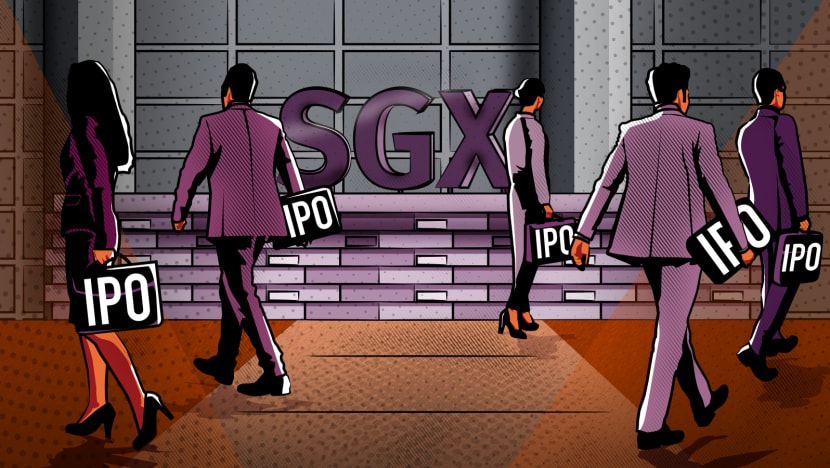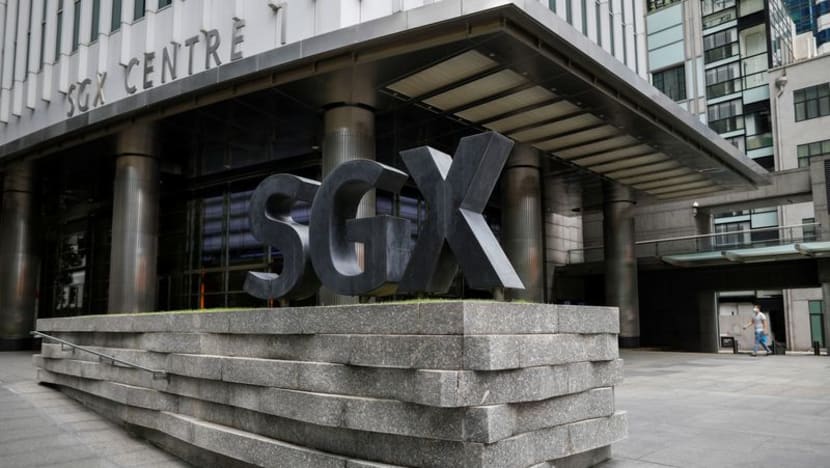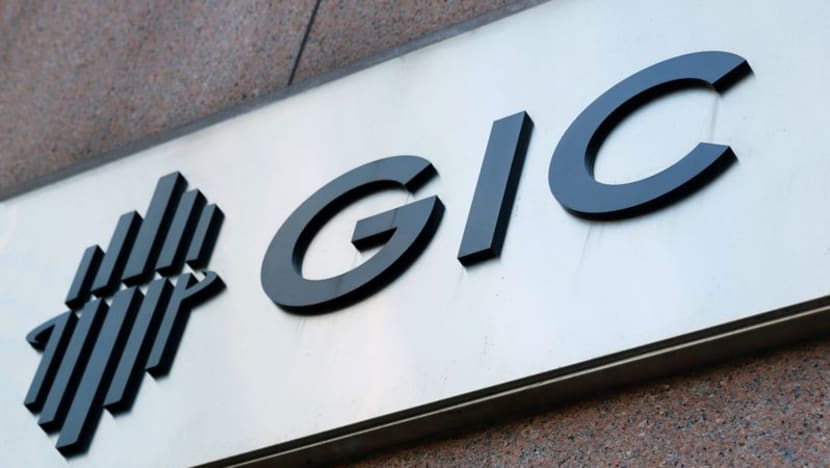IN FOCUS: Singapore’s stock market at ‘rock bottom’. What will it take to shake things up?
For years, the Singapore stock market has been reeling from a "vicious cycle" of poor valuations, evaporating liquidity and a lack of new listings. What will it take to give the moribund market a shot in the arm?

(Illustration: CNA/Rafa Estrada)
This audio is generated by an AI tool.
SINGAPORE: Mr S Nallakaruppan recalls 1993 as the “golden year” for the Singapore stock market.
The Straits Times Industrials Index – as the blue-chip index was then called – was on a bull run, up nearly 60 per cent that year to rewrite multiple record highs.
Initial public offerings (IPOs) always generated excitement, with people lining up at Raffles Place to collect application forms being a common sight, recalled Mr Nallakaruppan.
“Applying for an IPO back then (felt) like winning the lottery. There’s very high chance of making some decent money,” he said.
But the biggest market event of 1993 was the public listing of Singapore Telecommunications (Singtel) on Nov 1. As part of the government’s efforts to share the nation’s wealth and enlarge the base of share-owning Singaporeans, shares were set aside to be issued to Singapore citizens at a discount.
The result was a key milestone in the local stock market.
Trading houses extended their operation hours on Nov 1 to accommodate the red-hot market activity for a record 12 hours, recalled Mr Nallakaruppan. Singtel eventually finished its debut trading day at S$4.14, more than double its issue price of S$2.
The vibrant stock market drove Mr Nallakaruppan to make the switch from accounting to stock broking a year later. But 30 years on, the remisier, who is now the president of the Society of Remisiers (Singapore), laments how things have changed.
The days of a buzzing stock market are long gone, he said. Low liquidity and poor valuations have instead become key characteristics of Singapore’s equities, alongside descriptors such as “boring” and “unexciting”.
These woes have prompted a steady stream of delistings over the years, while keeping away new listings. These in turn reinforced the perception of a lack of liquidity and poor valuations in the Singapore market – a “vicious cycle”, as some industry observers put it.
The market has hit “rock bottom”, said Mr Nallakaruppan, pointing to how the Singapore Exchange (SGX) has drawn only “one minuscule IPO” in the first half of 2024.
The sole new listing was cancer treatment provider Singapore Institute of Advanced Medicine (SAM) Holdings, which raised US$20 million (S$27 million) from its market debut in February. This was the smallest amount raised from an IPO in the region this year, according to a report by professional services firm Deloitte.
A “big bang approach” is needed to shake up the market, said Mr Nallakaruppan who proposed repeating the feat of Singtel by listing another “decent-sized” government-linked company.
“We need a jumpstart,” he said. “The moribund stock market is like a person in an intensive care unit and the heartbeat is getting flatline.”
There are also others calling for more radical measures to tackle the market’s challenges.
In May, the Financial Times reported that the SGX and other government agencies are studying proposals from a venture and private capital association that include allowing pension and sovereign money to be invested in the local bourse.
The discussion has since gone to parliament, but the suggestion that GIC should expand its portfolio to include the Singapore market seems to have been turned down by the government for now.
Second Minister for Finance Chee Hong Tat said on Jul 2 that directing the sovereign wealth fund to invest in locally-listed firms is “not the solution” for the Singapore equity market’s woes.
A “more sustainable way” is to groom and develop a pipeline of good companies to list on the SGX, Mr Chee had said.
Meanwhile, Temasek Holdings, Singapore’s other state investment entity, has said that reviving the stock market is “not (its) primary concern” and that its “mandate is to generate long-term sustainable returns”.
As attention remains on the state of the local equity market, SGX has held on to a sanguine outlook. Speaking at a Reuters conference on Tuesday (Jul 9), chief executive Loh Boon Chye said the exchange has “a healthy pipeline” of IPOs.
“Secondary listings are one way where companies get exposure – we have that in the pipeline. We have new IPOs, some companies are really now preparing, and ... we’re going to have a simultaneous dual listing,” he was quoted as saying.
A SHRINKING MARKET
Last year marked the worst year for listings since the SGX opened its doors in late 1999.
The local stock market drew just six IPOs in 2023, down from 11 in 2022. Funds raised came up to US$35 million (S$47.2 million), a whopping 92 per cent decline from the year before, according to Deloitte.
These anemic numbers leave Singapore far behind its closest competitor Hong Kong and regional peers. Indonesia, for example, was among the world’s top five IPO markets with 79 listings last year.
Up until 2015, the SGX had not seen fewer than 20 public floats a year.
The market appeared to have sprung back to life in 2017, with 20 new flotations raising S$4.6 billion. Nearly half of that came from the mammoth listing of NetLink NBN Trust, Singtel’s broadband unit, which was billed as the biggest IPO in years.
But the comeback did not last, as IPO numbers fell steadily to below 10 for the first time in 2021.
On the other hand, departures from the SGX have consistently stayed in double digits. There were 25 delistings last year, 36 in 2022 and 31 in 2021, based on reports by The Business Times.
Already, bourse data has shown at least 10 exits in the first five months of 2024. This figure is only set to increase, with privatisation bids ongoing for the likes of department store Isetan.
The result of this is a shrinking stock market, which had 632 listed securities at the end of last year, down from 665 in mid-2022 and 715 in May 2020.
Over the same period, the total market value of stocks listed on SGX fell by nearly 10 per cent, central bank data showed.
WHAT HAS GONE WRONG?
Calls to revive the Singapore stock market are certainly not new.
In 2015, a group of remisiers, including Mr Nallakaruppan, signed a letter of appeal to the government seeking urgent measures to restore confidence in Singapore stocks. A year later, the Singapore Business Federation made a call for funds from GIC to be used to revitalise the local market.
So, why are Singapore equities stuck in the rut of evaporating liquidity and losing the race for new listings?
Already hamstrung by a small base of retail investors, the local market has been hammered by a series of events and investors’ confidence never quite recovered, said Mr Nallakaruppan.
These events include the spate of corporate governance scandals involving S-chips, or China firms, listed here, in the mid-2000s and the 2013 penny stock crash. The latter wiped out S$8 billion in what authorities called the country’s biggest market-rigging scandal.
Then came the shocking downfall of water treatment firm Hyflux, once the darling of Singapore Inc, in 2018. Again, thousands of local investors bore the brunt of the losses.
“There is no recourse for all these investors,” said the remisier. “You get hit once, twice and people ... lose confidence.”
Daily Cuts: How can the Singapore stock market be revived?
But a bigger problem for Singapore is the lack of a sustainable cycle of institutional capital, according to some observers.
Many countries, such as the United States, Australia, Japan and Malaysia, have regulations to recycle a large part of their domestic savings – be it pension or retirement savings plans – and insurance monies back into their domestic markets, said Mr Chew Sutat, chairman of listed-company association SGListCos.
Australia’s superannuation funds, for example, allocated around 23 per cent of assets in shares listed in the country as of end-2023, based on figures released by the Association of Superannuation Funds of Australia.
Doing so has helped to keep the Australian market liquid and supportive of domestic listings. A buzzing local capital market in turn attracts international investors, said Mr Chew, before adding “it is a pity that Singapore has no such rules or culture to preference some for the local market”.
With the lack of a healthy mix of both retail and institutional capital, observers noted that it is not surprising that firms gunning for IPOs have chosen not to make SGX their home.
To be sure, IPO activities slowed globally last year amid still-high interest rates and geopolitical uncertainty. Private equity and family offices have also given small businesses “attractive alternative” fundraising options, said Mr Robson Lee, partner at Kennedys Legal Solutions.
But the gap between Singapore and its regional peers has widened, going by the latest IPO figures. In the meantime, several Singapore companies, like property tech firm Ohmyhome, cancer diagnostics firm Mirxes and ride-hailing app Ryde, have opted to list overseas.
At venture capital firm Trive, where five of its start-ups are mulling an IPO in the next three years, four have decided to list on the Nasdaq stock exchange in the United States.
“Only one has decided to consider a reverse takeover option on SGX for strategic reasons – its business model is more traditional in nature … and it didn't require a global presence of investors at this point,” said Trive’s managing partner Christopher Quek.

Aside from a lack of liquidity, SGX’s lack of appeal among tech upstarts can be attributed to several reasons including an “old economy” stock market driven by the banking and property sectors, as well as relatively conservative investors who prefer dividend-yielding blue chips.
In addition, market valuations here tend to require “a good track record of fundamental earnings before listing”, instead of taking into account a company’s potential, noted Mr Quek.
“Trive wanted to bring a certain series B profitable company towards the Nasdaq for a unicorn valuation. This is possible based on the investor story we are pitching,” the venture capitalist said.
“However, when considering the SGX, the M&A advisor gave us the reality that SGX investors will value the company on a fundamental basis and that will be 10 times less than the valuation that Nasdaq can support based on existing figures.”
Other exchanges are also not standing still, noted EY Asean and Singapore IPO Leader Chan Yew Kiang.
“They are revamping their regulations and listing rules to accommodate the listings of more new-economy companies, while delicately balancing it with guardrails to protect investors,” he said.
One example would be Britain, which on July 11 set out final rules for the biggest shake-up in how companies list on the London Stock Exchange. The changes aim to attract a wider range of listings by reducing red tape, and placing the onus on companies to decide what information they should disclose to potential investors.

GOVERNMENT MEASURES
The Singapore government has taken steps to boost the local stock market’s appeal.
Two funds – namely the S$1.5 billion Anchor Fund @ 65 and S$500 million EDBI Growth IPO Fund - were established in 2022 to support high-growth firms to raise capital through public listings here.
Fund managers do so by advising companies on the listing requirements of SGX, as well as facilitating engagements with investment banks and market makers, said a spokesperson from the Ministry of Trade and Industry (MTI).
Thus far, these funds have invested in nine companies to date, Mr Chee said in parliament last week.
Asked if this number achieves any initial targets set and whether the funds have been effective in rejuvenating the local stock market, MTI would only say that the last two years have been “more challenging for equity markets globally” with a decline in IPO activities amid the high interest rate environment.
The equity markets in Singapore and the region have been similarly affected, the spokesperson said.
MTI did not respond to additional questions from CNA for details about the nine companies that received support and whether other investments are in the works.
Meanwhile, there are also schemes to help defray listing costs and fund research coverage of SGX-listed firms.
As part of the Grant for Equity Market Singapore (GEMS) scheme launched in 2019, the Monetary Authority of Singapore (MAS) provides grant amounts of up to S$2 million that help offset listing-related expenses.
As of May, this grant has supported a total of 46 listings from sectors ranging from new technology, media and healthcare to information technology, an MAS spokesperson said.
Ten of these were mainboard listings, such as Nanofilm Technologies and Digital Core REIT. The remaining 36, including newly listed SAM Holdings, are listed on the Catalist board.
Also under GEMS, a research development grant has supported more than 10 research houses which hired 38 research analysts as of end-2023.
These research houses have produced over 900 research reports covering more than 130 SGX-listed companies, with information they contain providing insights for retail investors and helping better decision-making, MAS said.
“The GEMS grant funding is one of the factors that potential IPO aspirants take into account in considering a listing on our equities market,” the central bank spokesperson told CNA.
“MAS will review new ideas and proposals to improve our equities market and support business growth and will continue to work with industry stakeholders on this goal.”
On its part, SGX introduced new rules in 2021 to permit the listing of special purpose acquisition companies, or SPACs, on the mainboard and more recently, a Thailand-Singapore Depository Receipt was launched to broaden access to capital and markets.
It also started a market maker and liquidity provider programme in 2014 to boost trading volumes. The market operator declined to reveal the specifics of this programme, citing confidentiality.
SGX also declined to comment on other questions posed by CNA for this article, such as whether it is reviewing its existing initiatives to boost performance.
“JUST BAND AIDS”
Observers said these initiatives have had limited effect.
SGX’s enabling of SPAC listings, for one, was “the right move but came too late” when excitement over the listing structure had already fizzled out, said Kennedys Legal Solutions’ Mr Lee.
Mr Chew of SGListCos said listing grants are welcomed but will not be enough to sway companies as listing fees make up “only a fraction” of the total costs.
Failing to tackle the market’s systemic issue of a lack of sustainable liquidity domestically, these measures may be “just band aids and nice-to-haves”, he added.
The government has said that its approach is to develop a good pipeline of good companies that can list on the SGX. But schemes aimed at helping firms scale up and venture abroad remain more suited for those with traditional operations, said Mr Quek.
The venture capitalist has worked with start-ups to apply for grants, such as the Market Readiness Grant and the Enterprise Development Grant, and found that start-ups often have to “force-fit” their operations and processes to fit requirements.
Strict rules on qualifying expenses and a long approval time also serve as challenges for start-ups with limited cashflow. “The grants inadvertently become an impediment instead to the start-ups,” Mr Quek said.
“INVESTMENTS FROM GIC WILL BE A STRONG SIGNAL”
Several experts said the solution to the local stock market’s woes lies in having more institutional players that can “significantly move the needle” in trading volumes.
This is where sovereign money, such as GIC, could play a role – not just to inject new funds into the market but also much-needed confidence for others to follow, they added, despite speaking to CNA after the minister’s response in Parliament.
Minister Chee has said the government “should not direct or interfere with GIC’s investment decisions”.
“Doing so will compromise our objectives of setting up GIC, which is not beneficial for Singapore and Singaporeans,” he told the House.
While the experts agreed that GIC has a mandate to fulfil – that is to preserve and enhance the international purchasing power of Singapore’s reserves – they also reckoned that expanding the sovereign wealth fund’s portfolio to include the local market makes both investment and strategic sense.
“If it is (the) government’s goal to make the Singapore stock market more attractive to investors, it is helpful to see the government be willing to put more stakes in the market,” said Associate Professor of Finance Fu Fangjian from the Singapore Management University (SMU).
“Not surprisingly, investments from GIC will be a strong signal.”
“We believe that investing in Singapore stock market can achieve good long-term returns. It also provides the strategic benefit of enhancing Singapore as an international destination for raising equity,” said Phillip Securities Research head Paul Chew.
He suggested that GIC could seed a private-sector managed exchange-traded fund that is focused on local small and mid-cap firms.
This can help to “avoid the optics of a government-related agency backing or endorsing any specific small-mid cap company”, while helping to incubate small fund managers that specialise in small and mid-cap equities, Mr Chew explained.

The power of government intervention can be gleaned from the revival of Japan’s stock market, where a series of government actions has successfully sparked a resurgence in investors’ interest.
One of which was the Government Pension Investment Fund’s (GPIF) move in 2014 to double its domestic equity allocation target to around 25 per cent of assets, up from 12 per cent. This was the turning point that catalysed a “virtuous cycle” in Japan’s capital markets, said SGListCos’ Mr Chew.
To “avoid moral hazard”, the GPIF deployed its capital to local fund managers. This created “revenue for fund managers that flowed down to the investment bankers and brokers … and the sector, which was dying a slow death for 25 years, started hiring talent again”, he said.
Being the world’s largest pension fund, the GPIF’s allocation plan is also typically considered a bellwether for other investors, who returned gradually as market activity grew.
The use of a “small portion of Central Provident Fund savings allocated by the Ministry of Finance to GIC to manage for investments in the local stock market through local fund managers” could kickstart the same cycle in Singapore, Mr Chew of SGListCos noted.
WHAT ELSE CAN BE DONE?
But with the government ruling out GIC for now, other options may very likely need to be explored.
Another way to ensure sustainable liquidity in the capital markets is to require insurance firms to invest a certain amount of their funds in Singapore.
This is not unheard of, said Mr Chew of SGListCos, citing how insurers that offer participating and non-participating products in Malaysia are required to invest locally.
Other suggestions mooted by industry observers include having family offices, whose numbers have grown rapidly in Singapore in recent years, to commit to investing a certain percentage of their wealth in the local stock market.
Apart from addressing the issue of evaporating liquidity, efforts must be made concurrently to shore up market confidence and spruce up the depth of the local bourse.
These range from setting up an ombudsman office to help retail investors seek legal recourse, requiring listed companies to take action to improve their valuations, raising the visibility of smaller listed firms through more independent research and setting up a start-up-only bourse, the observers said.
The report from the venture and private capital association had proposed collaboration with other regional stock markets, including the potential for Singapore to host a regional exchange.
Citing Singapore’s inherent size limitations, experts largely agreed on the need for more partnerships.
“For example, if SGX can serve companies in ASEAN by working or merging with regional stock markets, I think it would expand SGX’s business in a sustainable way,” said SMU’s Assoc Prof Fu.
Mr Quek suggested setting up a separate bourse solely for start-ups in the region. While the idea of listing overseas is tempting, it also comes with the hurdle of familiarity bias.
“This occurs when stock market investors are unfamiliar with Southeast Asia, which they deem as exotic emerging markets. These investors will likely shun Southeast Asia-origin stocks,” he said.
The SGX also “plays a natural role to serve the start-up community for their exits” given how Singapore is a top start-up investment destination in Southeast Asia, said the venture capitalist.
Mr Lee, the capital markets lawyer, reckoned that local companies, especially smaller ones, should be more active in investor engagement. These include holding more investor relations activities, such as briefings and roadshows, to help revive investors’ interest.
It is also time to reshape the culture of equity research where valuations are typically derived from price-to-earnings ratio, he added.
Another metric to consider, especially for fast-growing companies that are not yet profitable or with low profits, could be the price-to-sales ratio which considers the total amount of annual sales generated. This can help to encourage promising companies that are in the new high-tech or deep-tech industries to consider a listing in Singapore, Mr Lee said.
Grants will remain a necessity to keep equity research going, especially as years of consolidation in the stock broking industry and thinning commissions have resulted in a rollback in investments and manpower in broker coverage.
“The wider market could do with more research coverage but funding will always be a problem,” said Mr David Gerald, founder-CEO of the Securities Investors Association Singapore (SIAS).
“What is lacking and seriously asked for by retail investors is the independent equity research reports to guide them to invest,” he added.
Echoing that, SMU’s Assof Prof Fu called for “a system to govern the analyst profession” to ensure high-quality equity research.
SIAS is also recommending that Singapore take a leaf out of Japan’s reform playbook to make it mandatory for listed firms to take action if their shares trade below their book values.
Market restructuring rules finalised by the Tokyo Exchange Group last year include requiring listed companies to “comply or explain” if they are trading below a price-to-book ratio of one – an indication a company may not be using its capital efficiently.
Said Mr Gerald: “In other words, shift the responsibility for increasing market interest to the companies themselves.
“After all, why should companies be allowed to list, then watch their share prices drift lower over the years, then delist at much lower prices if they themselves have not done anything to improve their situation in the intervening years?”
Lowball delisting offers are one reason for investor unhappiness and the retail investor advocacy group recently took a shot at companies with such plans, urging them to “provide an offer price which is truly ‘fair and reasonable’ to all shareholders”.
Lastly, SIAS also raised the idea of forming a joint task force, comprising MAS, SGX and associations like itself, “to provide a multi-faceted approach” to reviving the Singapore stock market.

WHAT AN ANAEMIC STOCK MARKET MEANS FOR SINGAPORE
Away from the stock market, Singapore remains a thriving financial hub, attracting global investors, hedge funds, private equity firms and more recently, the ultra-wealthy to park their wealth here.
But observers said the equity markets serve as means for companies, especially smaller and growing ones, to raise much-needed capital in any healthy economy.
With small and medium-sized enterprises accounting for around two-thirds of jobs in Singapore, it becomes crucial to ensure these firms have access to funds and be able to grow further, said Mr Chew of SGListCos.
“If the local capital market is not supporting our small and mid-cap companies and they have to depend on capital market far, far away, then I think we are doing a disservice to ourselves,” he continued.
“We may be surrendering our future economic sovereignty to someone else.”
A thriving stock market also helps drive business and employment opportunities. This goes beyond stock brokers to include a range of service providers in accounting, legal, to consulting and research firms.
Mr Lee, who has more than 30 years of experience as a capital markets lawyer, decided it was time for him to pivot in 2014 when the IPO market was slowing.
At the market’s peak, he would be involved in bringing five companies to list each year on the country’s stock exchange.
“An extremely busy period,” as he called it. These days, he remains busy but spends more time on merger and acquisitions matters, as well as helping businesses with regulatory compliance in the areas of environmental, social and governance and artificial intelligence.
Many others like him have also made the switch.
“You can’t just sit there and wait for work to come,” said Mr Lee. “You have to change before it’s too late.”














